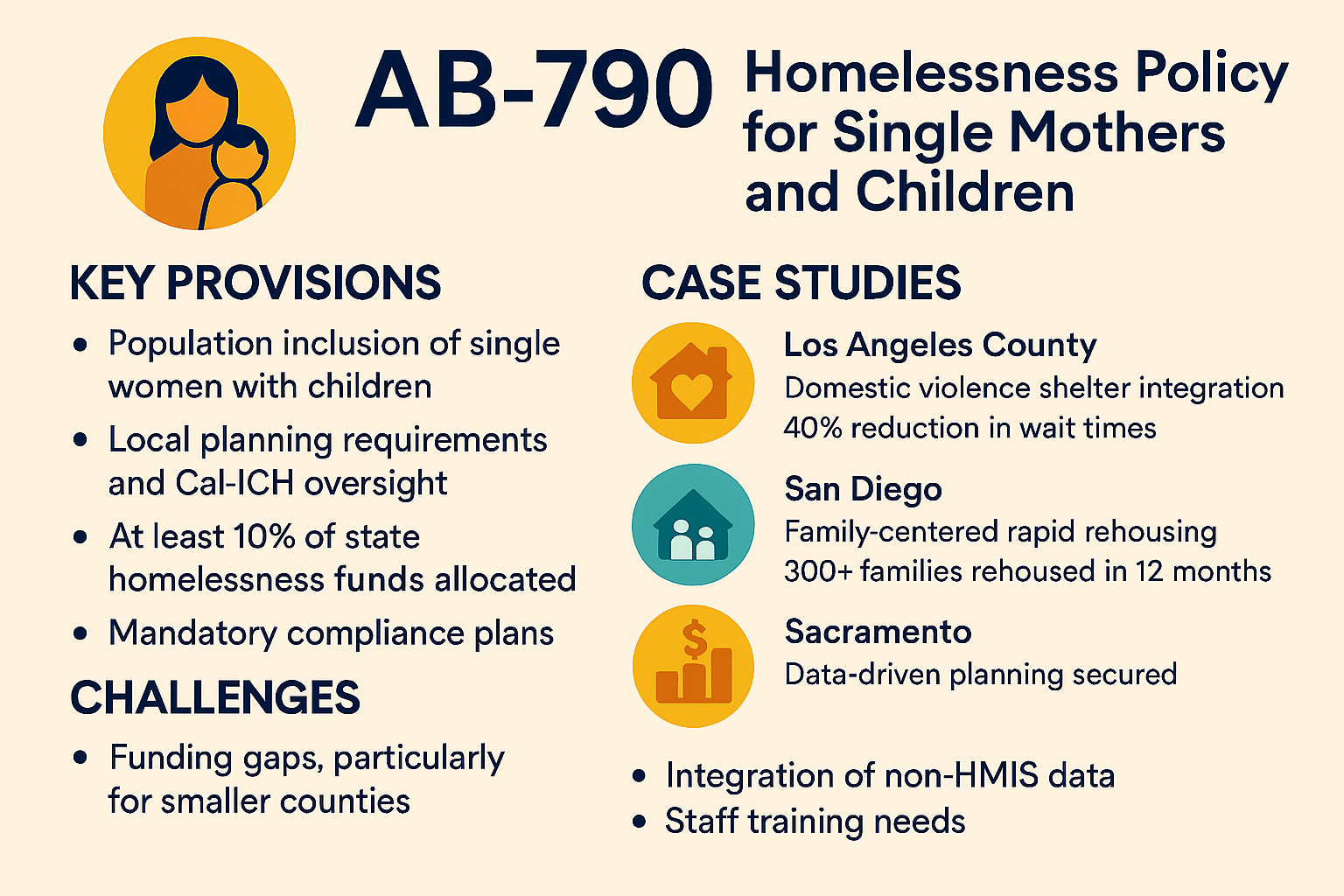Summary:
California’s homelessness crisis disproportionately affects vulnerable populations, including families led by single women. Assembly Bill 790 (AB-790), authored by Assemblymember Anamarie Ávila Farías and coauthored by Celeste Rodriguez, strengthens state and local obligations to address the unique needs of single women with children experiencing or at risk of homelessness.
Legislative Context
Existing Law requires cities, counties, and Continuums of Care (CoCs) receiving state homelessness funding to develop targeted supports for vulnerable groups such as families, domestic violence survivors, and unaccompanied women. These supports include housing delivery systems, data-driven analyses, and goal setting, all of which are carried out in collaboration with victim service providers.
AB-790 expands this framework by explicitly including single women with children in the definition of vulnerable populations, ensuring they receive priority in planning and resource allocation.
Key Provisions of AB-790
· Population Inclusion
o Single women with children are formally recognized as a distinct vulnerable group within homelessness planning mandates.
· Local Planning Requirements
o Cities, counties, and CoCs must:
§ Develop analyses and goals addressing the needs of single mothers and their children.
§ Incorporate non-HMIS data from victim service providers (e.g., domestic violence shelters).
§ Disaggregate bed counts provided by victim service organizations.
· Interagency Council on Homelessness (Cal-ICH) Oversight
o Cal-ICH must:
§ Post local analyses and goals on its website for public transparency.
§ Set measurable statewide goals and evaluate progress every two years.
· Provide technical assistance and coordinate with HUD when funding is available. Funding Allocation
o Qualifying state housing and homelessness programs must dedicate 10% of total funds to housing and services for single women with children who are homeless, at risk, or fleeing domestic violence.
· Compliance and Accountability
o Organizations receiving funds must submit a comprehensive compliance plan detailing how they will meet these requirements.
Policy Rationale
Single mothers with children face compounded risks:
- Domestic violence is a leading cause of family homelessness.
- Lack of childcare and income stability creates barriers to housing access.
- Traditional homelessness programs often fail to address family-specific needs, such as safety and trauma-informed care.
AB-790 aims to close these gaps by embedding family-focused strategies into state and local homelessness systems.
Implications for Local Agencies
- Operational Changes: Agencies must integrate victim service provider data and justice involvement analysis into their planning.
- Financial Impact: Programs must allocate a fixed percentage of funds to this demographic.
- Public Accountability: Analyses and goals will be posted online, increasing transparency.
Real-World Case Studies
1. Los Angeles County – Domestic Violence Shelter Integration
Los Angeles County partnered with Sojourn Services to integrate domestic violence shelters into its homelessness response system. This collaboration:
- Provided trauma-informed housing navigation for single mothers fleeing abuse.
- Added real-time bed availability data from victim service providers to the county’s planning dashboard. Impact: Reduced emergency shelter wait times for single mothers by 40%, improving safety and housing stability.
2. San Diego – Family-Centered Rapid Rehousing
San Diego’s Bringing Families Home Program prioritized single mothers with children for rapid rehousing vouchers. Key features:
- Bundled childcare subsidies with housing assistance.
- Partnered with local nonprofits for wraparound services, including counseling and job placement. Impact: Over 300 families rehoused in 12 months, with 85% retention after one year.
3. Sacramento – Data-Driven Planning
Sacramento CoC implemented AB-790’s mandate by:
- Conducting a landscape analysis using victim service provider data.
- Identifying gaps in family-specific shelter beds and transitional housing. Impact: Secured $2.5 million in state grants to expand family shelters and create dedicated units for single mothers.
Challenges Identified
- Funding Gaps: Smaller counties struggle to meet the 10% allocation requirement.
- Data Integration: Non-HMIS data from victim service providers requires new protocols for privacy and security.
- Staff Training: Agencies need cultural competency and trauma-informed care training.
Policy Implications
AB-790 moves beyond generic homelessness policy by embedding family-focused strategies into governance. These case studies show:
- Collaboration with victim service providers is essential.
- Bundled services (housing + childcare + counseling) improve long-term outcomes.
- Data transparency drives resource allocation and accountability.
✅ Compliance Checklist for Agencies
- Identify single women with children as a vulnerable population in homelessness plans.
- Develop local analyses and goals that address their specific needs.
- Integrate non-HMIS data from victim service providers.
- Disaggregate bed counts for domestic violence shelters.
- Allocate at least 10% of applicable state homelessness funds to this population.
- Submit a comprehensive compliance plan for state funding.
- Coordinate with Cal-ICH and HUD for technical assistance.
- Ensure public posting of local goals and progress.
- Evaluate and report progress every two years.
- Train staff in trauma-informed and culturally competent care.
Conclusion
· AB-790 sets a precedent for addressing the intersection of gender, family structure, and housing insecurity. Real-world examples from Los Angeles, San Diego, and Sacramento demonstrate that targeted interventions can significantly improve housing stability for single mothers and their children, offering hope for a brighter future.
· AB-790 represents a significant step toward equity in homelessness policy, ensuring that single mothers and their children receive targeted support. By mandating funding allocations, data-driven planning, and public accountability, California is setting a precedent for addressing the intersection of gender, family structure, and housing insecurity, providing reassurance for the future.
